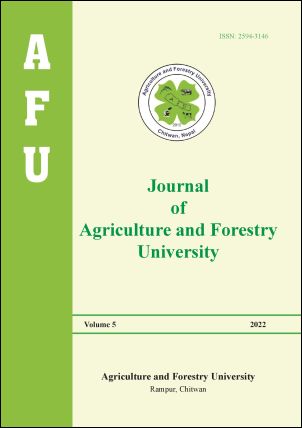Evaluation of reproductive performance and litter traits of Khari, Jamunapari and Sirohi crossbred goats in Surkhet district of Karnali province, Nepal
DOI:
https://doi.org/10.3126/jafu.v5i1.48444Keywords:
Breed, parity, production system, season, weightAbstract
Goat produces 20.36% of meat, ranking in second position after buffalo meat production in Nepal and contributes 4% in agriculture GDP. Making out the influence of non-genetic factors on the phenotypic expression of reproductive and litter traits of goat is important to develop selection/evaluation criteria with healthier precision. Khari, Jamunapari and Sirohi crosses were considered for the comparative study of their reproductive and litter traits. Data obtained from the study of different reproductive and litter traits were firstly entered into the computer via excel package programs. The data were analyzed by Mixed Model Least-square and Maximum Likelihood Computer Program PC-2statistical package developed by Walter R. Harvey and the means were compared by Duncan’s Multiple Range Test (DMRT). Results revealed that the pooled means for AFC, AFK, PPE, GL, and KI were 344.31, 493.69, 173.42, 148.93, 319.58 days respectively. Similarly, pooled means for LSB, LWB, LSW, and LWW were 1.43, 5.16 kg, 1.37 and 28 kg respectively. Production system and breed were important nongenetic factor affecting reproductive traits significantly whereas parity is the most important non genetic factor affecting litter traits of goat. Almost all of the reproductive traits (except PPE) were observed better under the grazing system in Khari breed. Winter kidding goat had better PPE. Likewise, all the litter traits were significantly better in later parities with almost similar performance in all the breeds. To summarize, Khari was explored as a high potential goat regarding its reproductive traits with a massive scope of improvement in its litter weight trait through effective selection measures within the population.
Downloads
Downloads
Published
How to Cite
Issue
Section
License
Copyright (c) 2022 Agriculture and Forestry University (AFU), Rampur, Chitwan, Nepal

This work is licensed under a Creative Commons Attribution-NonCommercial 4.0 International License.
This license allows reusers to distribute, remix, adapt, and build upon the material in any medium or format for noncommercial purposes only, and only so long as attribution is given to the creator.




